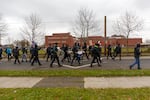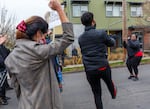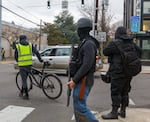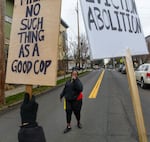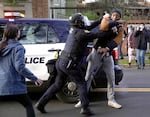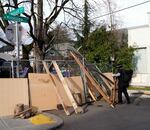Protesters are in a standoff with law enforcement over an eviction effort in North Portland. Barricades and improvised spike strips line the streets around a house on North Mississippi Avenue, and protesters have said they aren’t leaving until their demands are met.
Meanwhile, city officials and police have worried the barricaded zone could become an autonomous area without government rule, much like what happened this year in Seattle’s Capitol Hill neighborhood.
While the standoff has sparked significant attention, the events leading to the barricades around the so-called “Red House” are complex.

A quiet morning, Dec. 10, 2020, at the red house on North Mississippi in Portland, where protesters have been camped out at the home of the Kinneys, a Black and Indigenous family that has lived there for over six decades and are facing eviction. North Mississippi is blocked in both directions.
Kristyna Wentz-Graff / OPB
What is the Red House on Mississippi?
The Red House on Mississippi is an 1800s-era home that members of the Kinney family have owned since 1955. A website devoted to their eviction fight says the family came to Portland from Arkansas and bought the house in cash because Black families at the time were prevented from getting home loans. The neighborhood in North Portland was predominantly Black for generations, but in recent years has been developed and aggressively gentrified. Former residents of the area have hold stories of developers going door to door during the housing crisis offering stacks of cash for homes.
The Kinney family is one of the few remaining Black families that have been in the neighborhood since before the 2008 financial crisis.

Wednesday, Dec. 9, at the so-called "Red House" on North Mississippi in Portland, where protesters have camped and blocked surrounding roads in an effort to prevent eviction of the family that has lived there for decades.
Kristyna Wentz-Graff / OPB
What led to the foreclosure?
Members of the Kinney family took out a mortgage on the home to pay legal bills after their son, who goes by the name William X Nietzche, was arrested in 2002 for a hit-and-run collision. In 2016, their mortgage was transferred to a different firm but the loan servicer remained the same. Then the loan servicer changed too. Until that point, the family had been paying their mortgage on time. When the mortgage changed hands, the family said they became confused and stopped paying in order to figure out who the proper recipient was.
In a January 2017 letter, the Kinneys were told to start making mortgage payments to a different company. For two months, Nietzche said, the family received bills from two companies.
At this point, court documents show multiple written communications between Nietzche and Rushmore Loan Management Services LLC, the new loan servicer. According to federal court documents, those communications included letters from Rushmore verifying they were the loan servicer and telling the Kinney family that it was seven payments in arrears.
The mortgage was sold once again, this time to U.S. Bank Trust, and in 2018 the home was started in the foreclosure process.
Why were protesters drawn to this cause?
Like many cities, Portland has seen extensive protests for racial justice this year. Protesters demonstrated against police brutality for more than 100 consecutive nights through the spring and summer. At times the protests drew thousands of people. While nightly demonstrations have ended, smaller groups of racial justice protesters are still active in the city.
Related: As Portland protests resume, demonstrators remain resolute in push for racial justice
Some of those demonstrators have rallied around the Kinney family and have camped near the home since September in an effort to prevent their eviction.
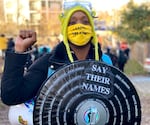
Racial justice activist Demetria Hester gathers with other protesters outside the Red House in North Portland on Tuesday, Dec. 8, 2020.
Sergio Olmos / OPB
North Portland, where the Kinney home is located, also carries significance more broadly in the city. Black Portlanders have historically faced significant housing discrimination and segregationist policies that largely restricted them to buying homes in North and Northeast Portland. As the city grew into its current state, many of those same Black families were forced out of their homes by skyrocketing costs and other pressures of gentrification. Until recently, the Kinneys were a family who had survived those pressures in one of the whitest major cities in America.
Many protesters occupying the area around the home say Portland city leaders should try to preserve the Kinneys’ place in the neighborhood.
How have housing markets led to this conflict?
There are two types of foreclosures in Oregon, judicial and nonjudicial.
Like the name implies, a judicial foreclosure goes through the courts. The homeowner is sued in state court and the foreclosure goes before a judge. For homeowners, a judicial foreclosure provides multiple added layers of protection. After a judicial foreclosure, homeowners have six months to buy back their home for the price paid at auction. If the home was auctioned for less than the original mortgage, this could even work to the original homeowner’s benefit.
Nonjudicial foreclosures, such as the one the Kinneys went through, don’t involve courts. The loan servicer gives the homeowner notice of default and “home loss danger.” That note includes the amount of the debt and a sale date, time and place. Nonjudicial foreclosures do not allow homeowners an opportunity to buy back their property after auction.
After lawsuits stemming from the financial crisis halted nonjudicial foreclosures, the practice is once again becoming more frequent. Banks prefer them because they are cheaper, easier and the property isn’t tied up for six months after auction to allow for the state mandated right of redemption.

A quiet morning, Thursday, Dec. 10, 2020, at the Red House on North Mississippi in Portland, where protesters have camped out in an effort to fight the eviction of the Black and Indigenous family that has lived there for over six decades.
Kristyna Wentz-Graff / OPB
And since it is up to the loan servicer to decide which process to use, they increasingly are opting for nonjudicial foreclosures. If a homeowner facing a nonjudicial foreclosure wants to get the process into court, they have to sue the loan servicer and get a temporary restraining order.
Over the past 15 years, as the effects of the financial and housing crisis of 2008 persisted, judges have learned more about the ins and outs of the mortgage industry and become more skeptical of banks.
“It’s judicially supervised and, in theory, the banks can’t just get away with murder,” said Terry Scannell, a Portland-based attorney who specializes in complex civil litigation. “There’s someone watching.”
The mortgage market is filled with conflicting economic interests often at odds with the idea of keeping homeowners in their homes, according to Scannell.
Loan beneficiaries, the people who benefit when you pay your monthly mortgage payment, aren’t necessarily the same people who you actually send your money. That is the loan servicer.
Unlike the beneficiary, loan servicers make their money by taking a small cut of the debt’s unpaid principal. The bigger the outstanding balance on your mortgage, the more money they make. If you pay down your mortgage, the servicer makes less money.
Scannell said the dramatic increase in North Portland property prices has put an even wider gap between homeowner incentives — paying their mortgage and keeping their home — and loan servicer incentives.
As soon as a home is in default or a foreclosure has begun, servicers can make even more money because they can charge a variety of fees. If a home is worth substantially more is owned on the associated mortgage — one impact of gentrification — the servicer knows they will come out ahead. In the Kinneys’ case, the family owed $112,338 at the time of their foreclosure. The property sold in November 2018 for $260,000, and is now valued at around $450,000.
“All the economic incentives become to grab the house and foreclose,” Scannell said. “Once you trigger and you’re put into a foreclosure, the whole system is geared to taking that house. The only thing that will stop them is a lawsuit.”
Scannell said loan-service companies can lull homeowners into believing they want to work with them to keep them in their house, while discouraging people from seeking legal help. Foreclosure, he said, comes with feelings of shame and is incredibly stressful.
“I’d say enormous amounts of people that go through this are literally in very high levels of emotional distress and so they freeze and don’t know what to do,” Scannell said. “And in the meantime, in a nonjudicial foreclosure, the industry will send the same person 23 notices of foreclosure in the mail. I think that’s done on purpose just to freak them out.”
Some servicers, he said, have hired psychologists to refine this system.
It’s a problem that has been rampant throughout North Portland, Scannell said. And while the Kinneys’ case looks like it probably could have been resolved early if they’d had a lawyer, he said there are countless other families experiencing the same or worse predatory foreclosures throughout the city.
Why didn’t the family resolve this in court?

Neighbors go about their morning walks past the protester-erected barricades, Dec. 10, 2020 at the red house on North Mississippi in Portland. Protesters erected the barricades three days ago at the home of the Kinneys, a Black and Indigenous family that has lived there for over six decades and are facing eviction.
Kristyna Wentz-Graff / OPB
The Kinney family never retained a lawyer. The family said is has struggled to find an attorney who would take its case. One family member, Nietzche, told OPB they contacted a number of attorneys and were turned down. Nietzche ended up representing the family himself.
Since the foreclosure, the family, still choosing to represent themselves, has filed lawsuits in Oregon state and federal courts. They lost repeatedly.
“If you look at the case in terms of what a just system would do versus what the law is doing to these people, it’s a stark difference,” said Jesse Merrithew, a Portland-based civil rights attorney.
Merrithew said he sees situations like this often when he reviews civil rights cases of prisoners who represent themselves in court.
“They try to make their arguments sound legal and that’s almost always a mistake,” he said. “And they end up filing things that aren’t following the rules the court has because they aren’t lawyers. For the lawyers on the other side, it’s really easy to just run circles around people who are doing that.”
Adding to the legal trouble, some of Nietzche’s court filings contain anti-government, sovereign citizen arguments that say he is not subject to U.S. law.
What is sovereign citizen ideology?
The sovereign citizen movement in the United States encompasses a wide array of beliefs but largely centers on false legal arguments that the federal government is illegitimate or doesn’t have jurisdiction over a person. The movement is often associated with militias and far-right groups, such as the Bundy family, but tax evaders and people with less political motivations have also used sovereign citizen arguments in court.
Related: Ryan Bundy declares himself an 'idiot' not subject to US courts
Nietzche’s filings point in particular to his belief in Moorish sovereign citizenship, an offshoot of the movement that grew in numbers in the mid-1990s, according to the Anti-Defamation League. It merges Black identity with sovereign citizen ideology.
Court filings and statements by Neitzche show that he has at times filed criminal complaints against judges and other officers of the court, sought citizen arrests, and cited his Indigeous heritage as reasons to oppose court rulings that supported the foreclosure process on the Kinneys home.
Neitzche’s social media accounts contain posts that also refer to QAnon and other unfounded conspiracy theories.
Related: Video: How QAnon conspiracy theory gained 2020 campaign traction

Protesters have blocked off street access to an area in Portland's Mississippi district.
OPB / OPB/Microsoft Bing
Isn’t there an eviction moratorium?
Like many places in the country, Oregon is under a statewide eviction moratorium due to the COVID-19 pandemic. That moratorium prevents landlords from evicting tenants during the pandemic, but does not absolve those renters from owing back payments.
The courts have allowed the Kinneys’ eviction process to move forward, largely because the home was foreclosed in 2018, well before the pandemic began.
Still, protesters have argued that evicting a family in the middle of a pandemic is cruel and potentially life-threatening.
Journalists were attacked in the barricaded zone around the home this week. Is it safe there?
Protesters have been regulating who can enter the area, banning anyone from taking photos or video, including pedestrians and neighbors out walking. Some have enforced that policy through violence, though most confrontations have been verbal.
One journalist was assaulted Tuesday while trying to enter the area. Protesters surrounded a TV crew from KATU with umbrellas to prevent them from filming. One protester grabbed a phone out of the hand of a KATU journalist, smashing it on the ground with their heel. When the journalist went to retrieve her phone, the protester stepped on her hand.
People who livestream video on social media are told to stand in a designated area, and they are prevented from walking around or livestreaming the inside of the barricade zone.
Police are being prevented from entering the area, as well. In a statement Wednesday, Portland police said they were concerned about fire and emergency medical services being able to access the occupied zone if needed.

Police arrest a protester outside the Red House in North Portland, where a group of people attempted to stop an eviction process, Dec. 8, 2020.
Jonathan Levinson
What are people who live in the neighborhood saying?
“It’s a mess down here, it looks like a war zone,” said Joel Miller, who lives across the street from the Kinneys’ home. “If I was the mayor, I’d come down and talk to them.”
Miller described the protesters as “very respectful,” and said he hadn’t had issues with them since they began camping in the area in September.
“They clean up after themselves, but they do play their music until five in the morning,” he said. “But I respect them because they stand up for what they believe in.”
Some neighbors’ vehicles are blocked in and are unable to move because of multiple barricades. Other neighbors said they have had their trash cans stolen. Many neighbors have “Black Lives Matter” signs in their windows.
“The police boycotted this area completely,” Miller said.
Are the city and the Kinney family working on a resolution?
Both sides have said they want to find a peaceful solution to the blockade. However, members of the Kinney family have expressed anger at law enforcement, who they said damaged or destroyed property inside the home during the eviction raid Tuesday. In a statement Thursday, they also said vehicles have antagonized the perimeter of the blockade. Videos posted online show people throwing fireworks inside at protesters.
The Kinneys have criticized the Portland Police Bureau for putting out statements calling the eviction blockade violent.
“Known white supremacists continue to illegally brandish arms without consequences,” the Kinney family said in a statement. “We refuse to be characterized as a violent movement when our leadership is rooted in an Afro-Indigenous ethic of land reclamation.”
The family said it was in communication with the mayor’s office and is trying to find a solution that will allow them to keep the home.





